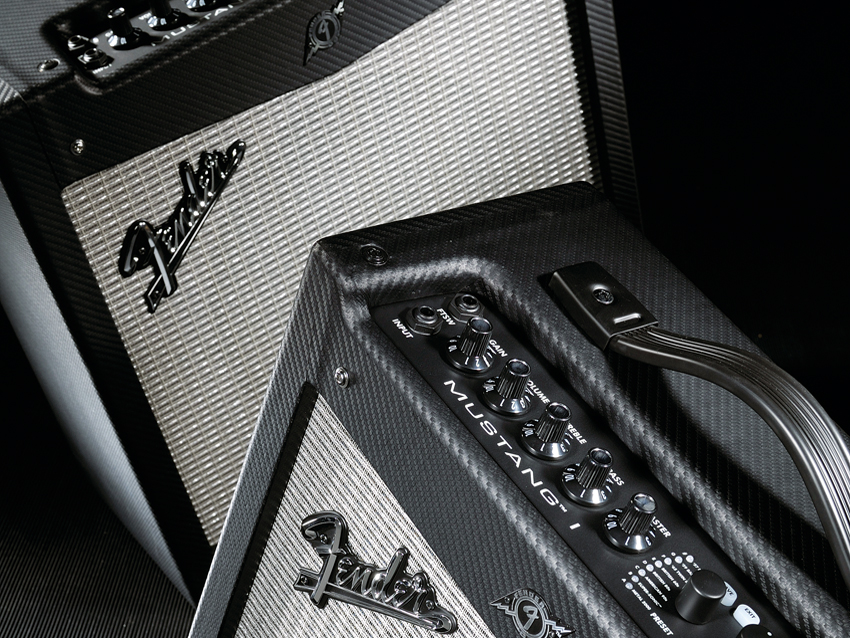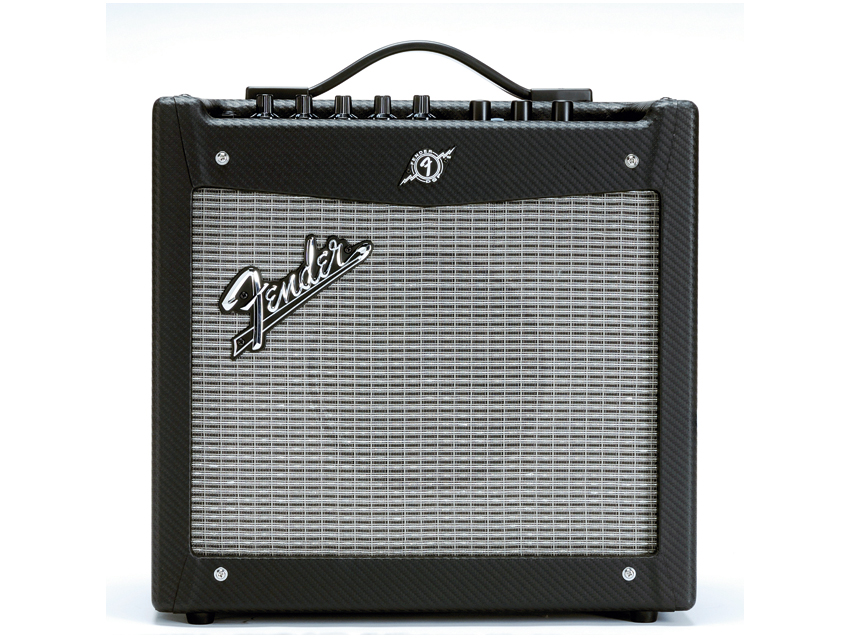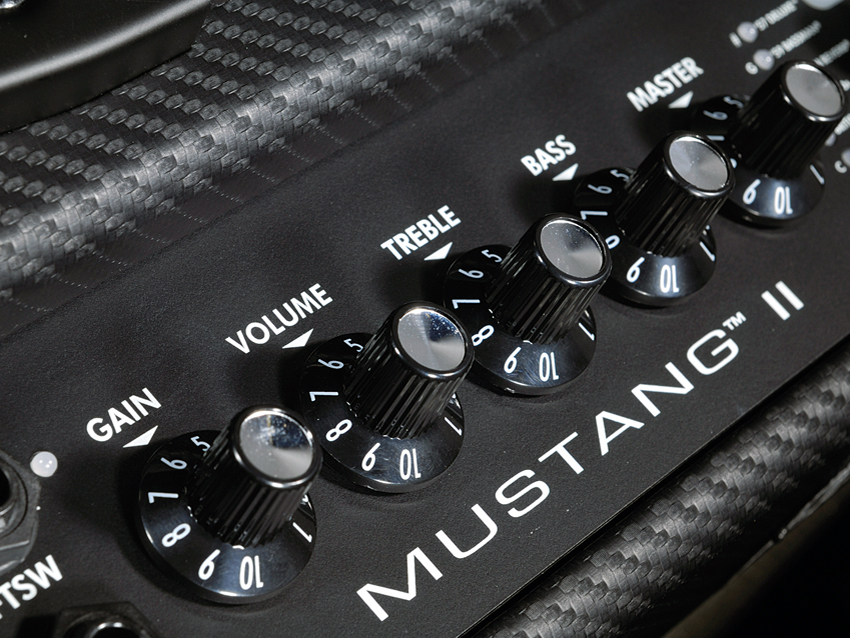MusicRadar Verdict
For vintage-flavoured practice or home noodling, these are genuinely impressive amps that recreate some of Fender's greatest moments.
Pros
- +
Great price. Satusfying tones. Easy to use.
Cons
- -
The metal sounds don't stand up to the clean ones in quality.
MusicRadar's got your back

Fender Mustang I & II

Mustang I

Mustang II
Most famously, the Fender Mustang is a quirky short-scale electric guitar launched in 1965, that later found favour with indie bands due to its cool shape and livery.
Joining it in the current-day corral are two new modelling amps that also use the Mustang moniker, but are as modern in specification as the Mustang guitar is now retro.
"Neither boutique nor expensive, they nonetheless deliver top tones for playing and practising."
The lion's share of the Mustang II's spec is shared by the I, and you can assume that what goes for the bigger amp is the same for the smaller unless stated.
In fact all that separates them is the output, speaker size and cabinet dimensions, all of which are listed in the spec check: the operating system we'll describe is the same.
The tones are based around eight amp models, with three versions of each: orange, red and green. They're accessed via a rotary pot that scrolls all the way through; all the oranges, then greens, then reds.
There are no menus to squint at, or multi-element LED displays to keep track of, so the Mustang is immediately easy to use.
Although loaded with tones from the outset, the concept is that you set up a sound in the non-editable orange banks, then save it to the specific amp model's red or green equivalent. Press the save button, scroll between red and green, then save again and it's done.
Want all the hottest music and gear news, reviews, deals, features and more, direct to your inbox? Sign up here.
The models comprise three of Fender's best-known amps, two British options and a trio of higher gain amps. All settings on the five-knob front panel, aside from the master volume, can be edited and saved.
Alongside the amps are a choice of effects and Fender has resisted the temptation to overload the Mustang with all manner of unusable noises in favour of different types of the same denomination of effect: chorus and deep chorus, a slow and fast Vibratone and so on.
There are also 12 reverb and delay effects - all of which are accessed, selected and edited via the mod or dly/rev pot.
Just how the effects are chosen comes across as a little clumsy in print so we'd suggest checking out the embedded video demo to see exactly how it's done.
The basic premise though, is straightforward. The mod and dly/rev knobs are divided up into four sections labelled A, B, C, and D. What's more, within each of these reside three effects - one, two, and three.
There are no notches to guide you nor, as we've said, a display to refer to, so the system can be a little fiddly at first, but the three small LEDs above the mod button illuminate to denote which effect you've dialled in.
For example, the octaver can be found as modulation effect C3, so, to access it, you need to rotate the mod pot to segment C and then stop when the three bulb lights.
It's possible to alter the wet mix: press the exit button while, at the same time, turning either the mod or dly/rev pot up or down depending on which effect you're editing.
What's more, the tap button not only regulates the delay time but can also be used to alter the speed of certain modulation effects.
For deep editing of effects and tones the Mustang comes out of the box with a DVD that, among other things, gives access to Fender's Fuse software, which allows you to really dig down into the amp via your computer. Even the most gnarly of luddites shouldn't be overly confused by this simple system.
Sounds
The Fender amp models are very impressive indeed. The '59 Bassman, the '65 Twin and '57 Deluxe options have much of their inspirations' tonality with the classic glassy treble and expansive low end present in absolute spades.
Dial-in a smidge of the impressive '65 spring reverb and it sounds (albeit doesn't particularly feel) like the 'real' thing.
There's no doubt that the II's 12-inch speaker gives a better overall tone than the eight-inch loaded into the I, but that's not to say that the smaller Mustang doesn't sound good in its own right.
In fact, some of the Fender tones are twangier through the smaller speaker and can be warmed slightly by tweaking the EQ or adding a hint of phaser or tremolo. The 40-watt II does offer more than enough poke to fulfil smaller gigs, however.
The British 60s model, which provides a thick and usable overdrive, is very enjoyable, but the higher gain models - most notably the American 90s and Metal 2000 options - aren't up to the standard of the rest of the amp.
That said, we understand why Fender included them and, with a high-powered humbucker, they do provide an approximation of the correct feel for hard rock and metal.
There's a rather involved method of utilising an optional two-way footswitch to flick between just two patches in real time but, for the simple enjoyment of playing for playing's sake, scrolling through the amp models is more than satisfying.
If you're umming and ahhing about which boutique five-watt valve combo you should buy for home use, do you yourself a favour and try one of these. Neither boutique nor expensive, they nonetheless deliver top tones for home playing and practising.
The Twin, Deluxe and Bassman models impress the most - good, usable sounds - while Metal 2000 feels like more of a box-ticking inclusion.
Thanks to the 12-inch speaker, the Mustang II is certainly the better sounding of the two but at a mere £108, the Mustang I is still a very impressive option.
For practice, laying down some demos and even getting in touch with other users online and swapping sounds, the Mustangs are a steal. And thanks to the accuracy of many of its amp models, we're hard pushed to think of a better mix of vintage-inspired tones, price and modern technology.
When compared with other modelling amps available today, the Mustangs could be considered a tad backward, but when the tones are as good as this, we'd urge you to adapt. Tons of fun for not much money at all.
Simon Bradley is a guitar and especially rock guitar expert who worked for Guitarist magazine and has in the past contributed to world-leading music and guitar titles like MusicRadar (obviously), Guitarist, Guitar World and Louder. What he doesn't know about Brian May's playing and, especially, the Red Special, isn't worth knowing.